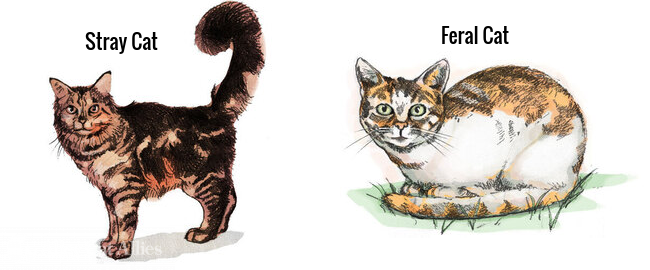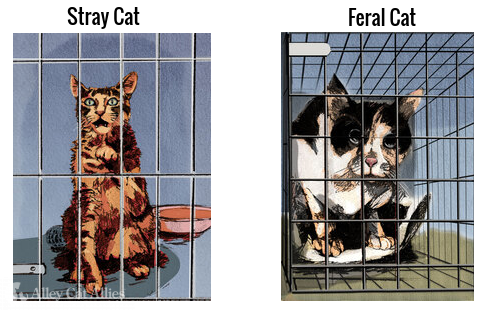Feral & Stray Cats: What’s the Difference?

Not every cat living outside is lost or abandoned. Feral cats, who have never been pets and live like raccoons and possums and other wild animals, roam the alleyways of cities and the fields of the countryside. Such cats can benefit from human care, particularly spaying and neutering, and they’ll appreciate feeding—but you definitely shouldn’t try to rescue them. They don’t want to become pets or live in houses. They don’t need to be rescued.
advertisement
What is a feral cat?
A feral cat is a cat who has either never had any contact with people or her contact with people has diminished over time. She is not socialized to people and survives on her own outdoors. Most feral cats are not likely to ever become lap cats or enjoy living indoors. Feral cats have had little or no contact with people, and so they are wary of us, and cannot be adopted. Feral cats have kittens that can be socialized at an early age and adopted into homes.
A feral cat’s level of socialization and behavior is not always black and white, particularly for feral cats that recognize their caregiver. They may show signs of familiarity, such as a tail up or hanging out on a caregiver’s porch, but these behaviors are usually limited to the cat’s interaction with the caregiver and only develop after building a relationship over time. Always remember: this does not mean that the cat is a good candidate for living indoors.
Feral cats have a home—outdoors. They live and thrive in every landscape, from the inner city to rural farmland. Since feral cats are not adoptable, they should not be brought to animal pounds and shelters, because there they will likely be killed.
How to tell the difference
Distinguishing a stray house cat from a feral cat isn’t always easy, though there are some clear indicators. A cat that has been “ear-tipped,” for example, is almost certainly feral. Look for one ear, usually the left, that’s cleanly squared-off rather than pointy. This mark indicates that a feral cat has been trapped before and spayed or neutered. It prevents those who work with feral cat colonies from retrapping cats unnecessarily.
A cat that’s friendly and comfortable around people, on the other hand, is definitely domesticated. “If it comes and rubs on your leg or meows at you, it’s a house cat,” says Jessica Gotthold, CEO of The National Foundation for Animal Rescue.
Some lost or stray domesticated cats, however, won’t be that comfortable with you right away. If they’ve been living outside for a while, they may have become more cautious and fearful of humans, even if they’re still struggling to survive on their own. “Sit outside with them, even if you can’t touch them,” says Doreen Kaminski, a longtime volunteer with Whiskers Pet Rescue in Southbury, Connecticut. “Bring food out, earn their trust.”
Abandoned or lost cats
Some pets are cruelly abandoned to fend for themselves, but there’s just as good a chance that a non-feral cat you find hanging around your yard has an owner somewhere who would like to see her come home. Offer food, if she seems hungry. Take her to a vet, if she’s obviously sick or injured. But use caution: Get someone to help if the cat tries to scratch or bite.
After you have attended to the cat’s essential needs, try to locate the owner, if you can. If someone comes forward claiming the cat, however, be careful. Leave some important information out of your description of the cat, a distinguishing detail such as a missing tooth, extra toes or that odd orange spot.
How do I tell the difference when the cats are outdoors?
Since it is difficult to determine each cat’s socialization during a stressful event such as trapping, it’s a good idea to observe cats on their own outdoors using the guidelines below. Remember that these guidelines are not hard and fast rules and that just one of these traits is probably not enough to draw a conclusion.
Bottom Line: If a cat you don’t know approaches you or if you can touch her, she is most likely not feral. Not all stray cats will do this though, especially at first—each cat will act differently in a variety of situations. More monitoring using these guidelines may be necessary to determine if the cat is socialized. When in a frightening or stressful environment—such as a trap or a shelter—a friendly stray cat may act like a feral cat, avoiding people and possibly even showing aggression to avoid being touched. A lot of cats seem feral in traps but are just afraid.
advertisement
Body Language and Reading It




Featured Articles

Polydactyl Cats: Just More Beans to Love
Polydactyl cats have become extremely popular in recent times. As a result, more and more people are interested in learning more about this six-toed cat and want to get one of their own. If you are a cat lover intrigued by polydactyl cats, you have come to the right place….

The Odd-Eyed Cat (AKA Heterochromia)
Cats are already beautiful and fascinating creatures, but people are bound to take notice when they have something as captivating as two different colored eyes. Odd-eyed cats always have one blue eye paired with either a green, yellow, or brown eye. This form of heterochromia occurs in other animals, including…

Why Do Cats Roll Over Into Their Backs But Not Let You Touch Their Bellies?
It’s common knowledge dogs love to have their tummies rubbed when they freely lay down before you and roll onto their backs. But, if you’re also familiar with cats, you know that when they roll onto their backs with their bellies exposed, rubbing the belly will most likely result in…
